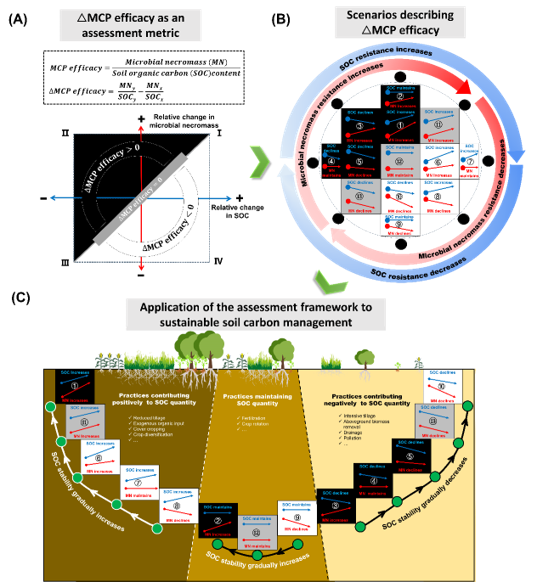Scientists Propose New Framework to Assess Soil Microbial Carbon Pump
A research team from the Institute of Applied Ecology, Chinese Academy of Sciences, has developed a novel framework to evaluate the soil microbial carbon pump (MCP), offering new insights into long-term carbon sequestration and sustainable soil management. The study was led by Dr. LIANG Chao and Dr. ZHU Xuefeng and published in Soil Biology and Biochemistry.
Soil carbon turnover and stabilization are central topics in biogeochemistry, influencing both soil health and climate regulation. In recent years, advances in soil research technologies and theoretical approaches have reshaped scientific understanding of how soil organic matter is formed and stabilized. Fundamental to this emerging consensus lies the concept of the microbial carbon pump, which emphasizes the role of microbial residues, known as microbial necromass, in forming stable soil organic carbon (SOC). While research on MCP’s contribution to SOC has grown rapidly, direct evaluation of its carbon sequestration function has lagged behind.
Building on a three-phase framework (Reaction, Behavior, and Effect), the research team concentrated on the long-term “Effect” phase of the MCP. They introduced a key indicator called ΔMCP efficacy, which quantifies the degree of synchrony or asynchrony between changes in microbial necromass and SOC levels. For clarity, synchrony refers to situations where microbial residues and SOC increase or decrease at comparable rates, while asynchrony highlights mismatched changes between the two processes.
The researchers constructed a comprehensive evaluation system that captures 13 possible scenarios of relative change between microbial necromass and SOC. Their findings suggest that simply measuring whether SOC increases can be misleading. For example, SOC gains dominated by unstable, easily decomposed carbon may not ensure long-term climate benefits. By contrast, SOC accumulation driven by microbial residues points to a more resilient and disturbance-resistant carbon pool.
According to the framework, a positive ΔMCP efficacy (greater than zero) indicates that microbial necromass contributes more strongly to SOC, reflecting higher carbon pool stability. A negative ΔMCP efficacy (less than zero) indicates either a faster turnover of microbial residues or an increasing proportion of non-microbial carbon sources, which could threaten the stability of the soil carbon pool.
The study reveals the importance of evaluating both the quantity and the stability of soil carbon in management practices. By distinguishing stable carbon accumulation from unstable forms, the MCP-based system provides practical guidance for policymakers and land managers. It allows rapid evaluation of soil carbon practices to ensure long-term carbon sequestration, ultimately contributing to climate mitigation and sustainable agriculture.
The researchers emphasize that this results-oriented evaluation bridges theory and practice, enabling more precise strategies for soil carbon management. Their contribution offers timely tools for enhancing carbon sinks during global efforts to combat climate change.

Figure1. Scenario analysis of microbial carbon pump efficacy and its application strategies for sustainable soil carbon management (Image by ZHU Xuefeng).



